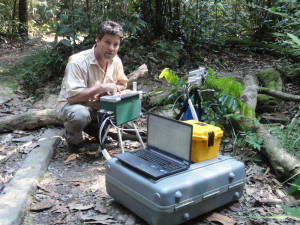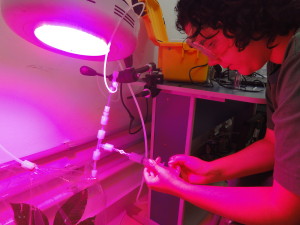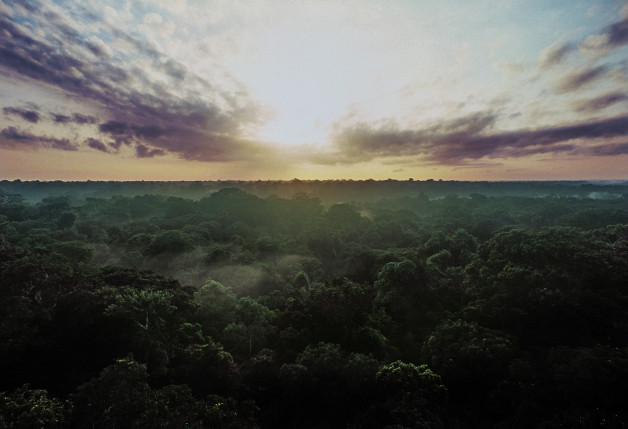Tropical forests play major roles in regulating Earth’s climate, but there are large uncertainties over how they’ll respond over the next 100 years as the planet’s climate warms. An expansive new project led by scientists from the U.S. Department of Energy’s Lawrence Berkeley National Laboratory (Berkeley Lab) aims to bring the future of tropical forests and the climate system into much clearer focus.
The project is called the Next Generation Ecosystem Experiments-Tropics, or NGEE-Tropics. Its goal is the development of a model that represents how tropical forests interact with Earth’s climate in much greater ecological detail than ever before. This will help scientists explore, more accurately than is possible today, how rising temperatures, shifting precipitation patterns, increasing greenhouse gas levels, and other natural and human-induced changes affect tropical forests’ influence on Earth’s climate.
The planned ten-year, $100 million project is supported by the Department of Energy’s Office of Science. The Department of Energy approved and supported NGEE-Tropics in early March.

NGEE-Tropics will link model development with field research. Berkeley Lab’s Jeff Chambers conducting plant physiology and carbon cycle research at a site operated by Brazil’s National Institute of Amazonian Research and located north of Manaus, Brazil. Photo credit: Kolby Jardine
“Tropical forests cycle more carbon and water than any other biome, and as such they’re a critical player in the planet’s energy balance and in climate change. But there’s a lot we don’t know. Through NGEE-Tropics, we plan to dramatically reduce this uncertainty to improve future climate projections,” says Jeff Chambers, an ecologist in Berkeley Lab’s Earth Sciences Division and the Principal Investigator and Project Director of NGEE-Tropics.
In addition to Berkeley Lab researchers, the effort includes collaborators from Brookhaven, Los Alamos, Oak Ridge, and Pacific Northwest national laboratories. The study also includes researchers from the Smithsonian Tropical Research Institute, the U.S. Forest Service, the National Center for Atmospheric Research, NASA, and several institutions from other nations, including Brazil’s National Institute of Amazonian Research.
More than a dozen other scientists in Berkeley Lab’s Earth Sciences and Computational Research divisions are involved in NGEE-Tropics, including Lara Kueppers, the Deputy Project Director.
Over the next decade, NGEE-Tropics scientists will collaborate with other researchers to carry out experiments in tropical forests around the globe. This research will fuel the development of a first-of-its-kind tropical forest ecosystem model that extends from the bedrock to the top of the forest canopy. The model will capture myriad soil and vegetation processes at a resolution better than ten kilometers. This is the resolution that next-generation Earth system models will achieve during the project’s lifetime.
During the first phase of the project, which spans the next three years, scientists will assess what’s known about tropical forest ecosystems and how well these processes are represented in models. Several pilot field studies will also be developed in phase one that link modeling advances with field observations.

In Manaus, Brazil, Andrea Teixeira of the National Institute for Amazonian Research works on a photosynthesis labeling experiment under a LED grow light. Photo credit: Jeff Chambers
One high-priority activity in phase one will explore how tropical forests respond to reduced precipitation, which is expected in some tropical regions. The study, in Manaus, Brazil, will investigate changes in the forest carbon cycle resulting from low water supply during the dry season from June through September. This is important for understanding whether tropical forests will respond to drought by releasing instead of accumulating carbon.
In another phase one activity in Puerto Rico, NGEE-Tropics scientists will study how soil fertility affects the regrowth of forests on abandoned agricultural land. These so-called secondary forests are known to take up CO2 from the atmosphere and store it for decades, but the rate of uptake is thought to depend on soil fertility. The research will involve measurements of phosphorus and nitrogen across different soil types. It will also involve airborne instruments, such as LiDAR to measure the forest structure and optical sensors to study the chemistry of the forest canopy.
And in Panama, scientists will use detailed datasets of species by species differences across regions to understand which characteristics enable some species to thrive under warmer or drier conditions, while others perish. The research will shed light on how forests dynamically respond to a warming climate.
Ultimately, the scientists will integrate what they learn from the pilot studies, and the more extensive field investigations in phases two and three, into their new tropical forest model.
“Our process-rich model will be applied within an Earth system model, and will greatly improve our understanding of how tropical forests respond to changes coming over the next century,” says Chambers.
###
Lawrence Berkeley National Laboratory addresses the world’s most urgent scientific challenges by advancing sustainable energy, protecting human health, creating new materials, and revealing the origin and fate of the universe. Founded in 1931, Berkeley Lab’s scientific expertise has been recognized with 13 Nobel prizes. The University of California manages Berkeley Lab for the U.S. Department of Energy’s Office of Science. For more, visit www.lbl.gov.
DOE’s Office of Science is the single largest supporter of basic research in the physical sciences in the United States, and is working to address some of the most pressing challenges of our time. For more information, please visit the Office of Science website at science.energy.gov/.
Additional information:
- Go here to learn more about NGEE-Tropics

